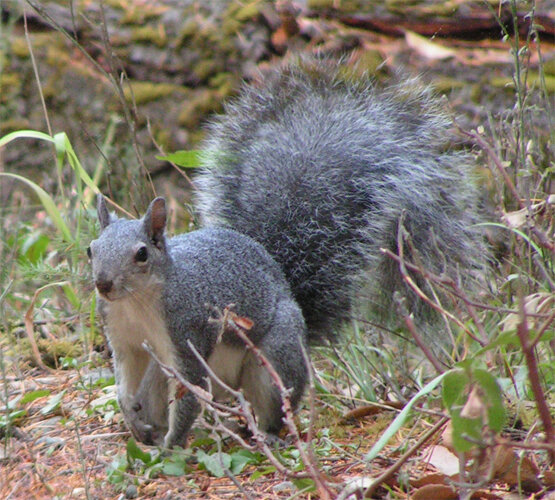Western Gray Squirrel
Sciurus griseus
Tree squirrels are the acrobats of the forests as they can often be seen hopping from tree to tree. They are territorial and will defend their territory from intruders. They establish territories of a size that will provide the necessities for survival: shelter and protection, food, and water. They nest in trees, occasionally enlarging a woodpecker hole or an existing tree cavity. The nest are called dreys. These are made of sticks and lined and insulated with softer materials such as moss. Western gray squirrels are diurnal. While out of the nest they spend time grooming, exploring, gathering food, and resting. Grooming can last from 3 to 15 minutes, with most of the time being spent on the head area.
Family:
Sciuridae (squirrel)
Description:
A large ( 20 inches overall; weighs 1 ½ -2 lbs.) , slender, silver-gray squirrel. An upraised tail is conspicuously bushy and edged with a salt & pepper appearance to dorsal fur; under parts white. It is very strongly muscled, used for tree climbing; sharp claws on all feet also aid in climbing.
Habitat:
Western gray squirrels are found in woodlands and coniferous forests. They can be found at elevations up to 8300 feet.
Range:
Western gray Squirrel lives on the west coast of the United States. They can be found in Washington, Oregon, California, and in a very small part of Nevada.
Diet:
Western grey squirrel's main source of food depends largely upon local habitat characteristics. Those that live in coniferous forests feed primarily on seeds of pinecones. Those that live in hardwood forests feed largely on nuts and acorns. Sciurus griseus is also known to eat berries, fungus, bark, sap, and insects. It opens hard seeds and nuts using its incisors.
Breeding:
Sexual maturity of western gray squirrel is reached at 10 to 11 months. When they are approximately one year old they will begin breeding. Breeding takes place once a year in the late spring. There are between 3 and 5 young per litter. Younger females generally have smaller litters than older females. The gestation period averages 43 days. Young are born without hair and with closed eyes and ears. The head and feet of young are large compared to the rest of the body. They are weaned at approximately 10 weeks.
Comments:
Voice a variety of hoarse, rough, coughing or barking sounds. Western gray squirrels are diurnal (daytime) and active all year, though they will hide in trees during bad weather. In winter, their footprints can be seen in the snow in Long Valley and around the Mountain Station.
mtm 02-27-2021


